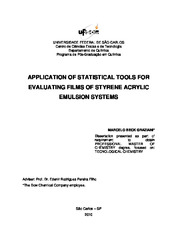Aplicação de ferramentas estatísticas para avaliação de filmes de emulsões estireno acrílicas
Abstract
This dissertation is focused on using statistical tools (Design of Experiments, DOE) and Principal Component Analysis (PCA) for evaluating latex film formation. The experimental part was conducted at Dow Brasil R&D facility in São Paulo. Samples were analyzed in triplicate using the following tests: scrub resistance, minimum film formation temperature (MFFT), drying time and Brookfield viscosity. Initially, four different coalescents were added into a single emulsion system at the following concentrations: 1, 2, 3 and 5% (w/w). Plots of results against coalescent concentrations were used for comparison, as a standard coalescent evaluation approach. Subsequently the model was used to determine the numerical relationship that describes each test. Analysis of variance was done. It was possible to propose models for scrub resistance, MFFT and Brookfield viscosity. Drying time did not have valid coefficients for modeling. A Doehlert design of experiments was prepared using as variable coalescent type (X, Y and Z), coalescent concentration (0 to 5%, studied in 7 levels) and latex type (A, C, D, E and F). Additionally, seven samples were prepared for model validation. A model was run to determine the equation that describes each test. Variance, lack of fit and pure error analysis were applied. It was possible to propose models for scrub resistance, MFFT, drying time and Brookfield viscosity. For each test a PCA was performed using the following variables: coalescent concentration, coalescent type, latex type and the response of each specific test. Models were run using the first principal component scores and DOE variables. Again, variance, lack of fit and pure error analysis were applied and models were proposed. Comparing these two approaches showed that using PCA was more appropriate to extract information from raw data. Based on PC scores models, scrub resistance, MFFT and drying time contour plots were prepared. Desired results (maximum of scrub resistance, the minimum of MFFT and the shortest drying time) were highlighted in order to identify the best combination of coalescent concentration and latex type. In this case, coalescent concentration between 1.7% and 5.0% and coalescents A and/or F were optimum. Experimental results from the validation set were compared with model ones and, in average, there was about 80% of concordance between them.
